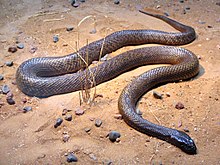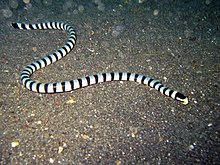Poison snakes
| Poison snakes | ||||||||||||
|---|---|---|---|---|---|---|---|---|---|---|---|---|

Black tiger otter ( Notechis scutatum ) on King Island |
||||||||||||
| Systematics | ||||||||||||
|
||||||||||||
| Scientific name | ||||||||||||
| Elapidae | ||||||||||||
| F. Boie , 1827 |
The poisonous snakes (Elapidae) are a family of snakes (Serpentes) that includes around 250 species. They are the second large group of poisonous snakes next to the vipers (Viperidae). Within the Venomari there are many species with highly effective nerve agents , for example, Taipan , cobras , mambas , Tiger otters or pseudonaja . In contrast to the snakes (Colubridae), venomous snakes produce a poisonous secretion, which can be injected into a prey or a potential enemy through the poisonous teeth in the front of the jaw .
features
Poisonous snakes differ from the closely related snakes by the special poisonous teeth, by the nostrils lying on the side and the lack of a loreal . A number of genera have an expandable neck shield that is spread out in a threatening position. Sea snakes show a physique adapted to life in the sea with various modifications of the internal and external anatomy.

The most important difference to the snakes is the structure of the venomous apparatus and the venomous teeth. These stand in the front of the jaw and are built proteroglyph (front, fixed furrow teeth), so they have a poison channel in which the snake's venom flows. In some species such as the South African spitting cobra ( Hemachatus haemachatus ), these teeth are modified in such a way that the snakes can spew the venom several meters away.
distribution
Poisonous snakes live in almost all tropical and subtropical regions and are found on all continents with the exception of Europe and Antarctica. In addition, the sea snakes belonging to them can be found in large parts of the warm sea areas, especially in the Indian Ocean and Pacific Ocean . The family only forms the most species-rich group among the snakes that occur in Australia, on other continents vipers are mostly represented and the real snakes are increasingly species-rich.
Systematics

The poisonous snakes are one of seven families within the superfamily of the adder-like and viper-like (Colubroidae). The system of snakes is still the subject of current research. The most important autapomorphy of the venomous snakes is the construction of the venomous apparatus with the proteroglyphic fangs in the front of the jaw . The also provided with poison glands deceit snakes include the Venomari accordingly not because their fangs are far back in the mouth - they are the snakes assigned (Colubridae). According to Pyron et al. the following system arises within the Colubroidae:
| Adder-like and viper-like |
|
||||||||||||||||||||||||||||||||||||
|
|
The venomous snakes are usually divided into two taxa, each of which is given the rank of subfamily. These are on the one hand the real poisonous snakes (Elapinae) and on the other hand the sea snakes and Australo-Asian poisonous snakes (Hydrophiinae). The following list shows the known genera of the group:

- Subfamily true poisonous snakes (Elapinae)
- Tribe Calliophini
- Jewelery otters ( Calliophis )
- Arizona coral otter ( Micruroides )
- Coral otters ( Micrurus )
- Sinomicrurus
- Tribus Hemibungarini
- Shield-nosed cobras ( Aspidelaps )
- Kraits ( Bungarus )
- Mambas ( Dendroaspis )
- African garter otters ( Elapsoidea )
- Spitting cobras ( Hemachatus )
- Hemibungarus
- Stomach glands otters ( Maticora )
- Naja ( Well )
- King Cobra ( Ophiophagus )
- Forest Cobras ( Pseudohaje )
- Desert cobras ( Walterinnesia )
- Tribe Calliophini
- Subfamily sea snakes and Australo-Asian poisonous snakes (Hydrophiinae)
- terrestrial genera
- Death adder ( Acanthophis )
- New Guinea Crown Snakes (
- terrestrial genera
- Australian copper heads ( Austrelaps )
- Crown snakes ( Cacophis )
-
Cryptophis
- Eastern small-eyed viper ( Cryptophis nigrescens )
- Australian brown snakes ( Demansia )
- Ornamental otters ( Denisonia )
- Drysdalia
- Bardicks ( Echiopsis )
- Elapognathus
- Furina
- Hemiaspis
- Harlequin Cobras ( Homoroselaps )
- Hoplocephalus
- Loverid gelaps
- Micropechis
- Tiger otters ( Notechis )
- Fijiottern ( Ogmodon )
- Taipane ( Oxyuranus )
- Black otters ( pseudechis )
- Brown otters ( Pseudonaja )
- Rhinoplocephalus
- Solomon rape
- Australian coral otters ( Simoselaps )
- Suta
- New Guinea wood adder ( Toxicocalamus )
- Rauschuppenotter ( Tropidechis )
-
Bandy Bandys ( Vermicella )
- Eastern bandy bandy ( Vermicella annulata )
- Acalyptophis
- Aipysurus
- Astrotia
- Disteira
- Turtle-head sea snakes ( Emydocephalus )
- Enhydrina
- Ephalophis
- Hydrelaps
- Oar snakes ( hydrophis )
- Kerilia
- Colpophis
- Plump sea snakes ( Lapemis )
- Parahydrophis
- Parapistocalamus
- Platelet Sea Snakes ( Pelamis )
- Thalassophina
- Thalassophis
- Flattail ( Laticauda )
literature
- Roland Bauchot (Ed.): Snakes . Bechtermünz Verlag, Augsburg 1998. ISBN 3-8289-1501-9
- Storr, GM, LA Smith and RE Johnstone: Snakes of Western Australia . Perth, 1986: p. 55, ISBN 0-7309-0399-0
- Chris Mattison: Encyclopedia of Snakes . BLV Verlagsgesellschaft mbH, 2007, ISBN 978-3-8354-0360-4
Individual evidence
- ↑ R. Alexander Pyron, Frank T. Burbrink, Guarino R. Colli, Adrian Nieto Montes de Oca, Laurie J. Vitt, Caitlin A. Kuczynski and John J. Wiens: The phylogeny of advanced snakes (Colubroidea), with discovery of a new subfamily and comparison of support methods for likelihood trees . In: Molecular Phylogenetics and Evolution . 2010, p. 329–342 , doi : 10.1016 / j.ympev.2010.11.006 .
- ↑ Elapidae in The Reptile Database
- ↑ The Reptile Database: Higher Taxa in Extant Reptiles - Ophidia (Serpentes) - Snakes.



